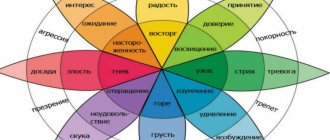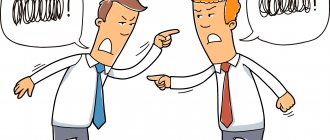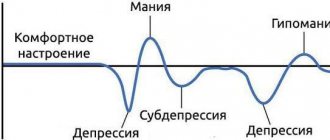In some diseases, the patient experiences a painful mental disorder, characterized by hostile thoughts and actions directed against his own personality. This condition is called auto-aggression. Self-destructive behavior can lead to dire consequences and cause death. To help patients suffering from this problem, the Leto mental health center prescribes specific treatment based on drug therapy and psychocorrection.
Causes of pathology
Auto-aggression is a painful response of the body to a critical situation.
Destructive behavior is caused by:
- Errors and deviations in raising a child. Constant humiliation, lack of love from elders, inflated demands, unfounded accusations and exaggeration of shortcomings, lack of attention, all of these formats can lead to the creation of a critical situation that destroys the threshold of stress resistance.
- Experienced violence, including sexual violence. An attack on a person often ends in self-destructive actions due to the resulting persistent stress.
- Fanatical devotion to ideas. Self-destruction can be driven by destructive religious faith, passion for aggressive esotericism, excessive love of diets, and the conviction of the need to increase physical activity to an exorbitant level.
- Dissatisfaction with professional employment. Often occurs when performing work that is contrary to existing desires.
- Family problems.
- Diseases that have a direct negative and powerful effect on the psyche.
- Hysterical personality accentuations.
Prevention
Prevention of auto-aggressive behavior can be of the following types.
By specialist
- Specialized psychiatric. This type of prevention includes medication and psychotherapeutic methods.
- Psychological. These are psychocorrectional programs aimed at changing personal attitudes, increasing self-esteem, developing an anti-suicidal barrier, and destroying factors that potentiate auto-aggression.
- General medical. This set of measures includes the elimination of the somatic and neurological consequences of the committed auto-aggressive episode.
- Social. This type of prevention includes changing the patient’s economic and social status, finding employment, obtaining additional education, and solving family and household issues and problems.
- Information and educational type of prevention. This is information about the need and measures to achieve a healthy lifestyle, signs of suicidal danger and assessing the risk of auto-aggression.
By sequence
According to the sequence, prevention can be of the following types.
- Primary . This type of prevention is understood as the prevention of autgression among all categories of the population. This includes strengthening mental health, creating a healthy lifestyle, comprehensive personality development, teaching productive behavioral strategies in times of crisis, as well as identifying a group at high suicidal risk and limiting the use of substances and means of suicide.
- Secondary prevention. It is carried out with those individuals who have attempted self-aggression. The goal of this type of prevention is to prevent relapse. For this purpose, pathogenetic treatment of the underlying disease, interpersonal-oriented and crisis psychotherapy are carried out. In general, secondary prevention is emergency measures aimed at preventing recurrent suicide in the short term.
- Tertiary . It is carried out with patients who have already committed suicide and their relatives for the purpose of rehabilitation. It is carried out with the aim of strengthening the anti-suicidal barrier and establishing family relationships. Treatment of post-suicidal encephalopathy is carried out, since in 78% of patients after an incomplete suicide, residual psychoorganic syndrome develops with subsequent disability, as it leads to severe cognitive impairment (decreased memory, intelligence, loss of household and professional skills).
Tips for parents
Auto-aggression in childhood and adolescence occurs not only after exposure to a traumatic factor, but also under the influence of the authority of any group or population. It is very important for parents to develop in their child the authority of a parent, an adult.
Photo: https://pixabay.com/photos/family-sunset-beach-happiness-2611748/
It is very important to remove the barrier between children and adults so that the child can tell what worries him, what problems he has and what is going on in his life in general - without the threat of punishment and fear of retribution for incidental mistakes.
It is important to limit the time spent on the Internet, replacing it with interests and hobbies in real life - active sports, travel, artistic pursuits. Spending time together will allow you not only to get to know your child better, but also to establish closer contact with him.
Kinds
There are several classifications of auto-aggression. The doctor is primarily interested in the main component – the cause of the disease.
In accordance with etiological factors, the following forms of self-destruction are distinguished:
- Mental. It includes personality traits that, under the influence of internal and/or external stimuli, are reduced into self-destructive actions. The main manifestations are self-blame and self-abasement.
- Physical. The symptoms of this type of disorder are dominated by actions accompanied by violence against one’s body. The patient is capable of hitting himself, making punctures and cuts.
- Social. The patient isolates himself from communication and strives to become an outcast from society. At the same time, he has a paradoxical joyful reaction from the fact that people begin to react negatively to the sick person.
- Moral. Characterized by dependencies. Suffering from alcoholism or drug addiction, a person deliberately isolates himself from other people, undergoes self-exhaustion, and emotional devastation.
Establishing the characteristics of this nature allows the psychiatrist to take a more selective approach to the treatment of deviation.
PARENTS' MISTAKES
- Low level of trust and cohesion in the family. If parents and children do not support each other, constantly criticize and control, then the risk of auto-aggression in younger family members increases significantly.
- Dysfunctional family parenting style. Auto-aggression occurs in authoritarian, overprotective and permissive families, where control over the child is either greatly exaggerated or completely absent.
- Different parenting styles among parents. For example, an authoritarian mother and a liberal father can cause an intrapersonal conflict in a child, which he will try to resolve through self-harm.
- Family ban on showing emotions. By forbidding the child to stomp his feet out of anger and resentment, parents provoke him into self-aggression.
- Presence of a model of aggressive behavior in the family: dad is aggressive towards mom, mom is aggressive towards animals, parents are aggressive towards children. Observing the behavior of the parents, the child also becomes aggressive, and unconsciously chooses himself as the object of the outburst of anger.
- Lack of emotional contact with the baby. If parents do not understand his feelings, then he may begin to demonstrate them through auto-aggression.
- Inconsistent behavior of parents when communicating with their child. The child must clearly know what he can and cannot do. When a ban or permission is canceled a few minutes after voicing, the child also experiences an intrapersonal conflict.
Symptoms and complications
Signs of auto-aggression can be both direct and indirect. In any case, the manifestations of this painful phenomenon are based on self-destruction. Symptoms vary widely.
Direct autodestruction most often includes:
- Hitting your head against the wall, floor.
- Cutting and biting yourself.
- Tearing skin with nails.
- Hair pulling, etc.
Indirect self-harm looks like:
- Tattoos.
- Specially made scars.
- Wearing objects that disfigure the body.
Other manifestations of auto-aggression include:
- Suicidal direction - thoughts of suicide, planning, thinking about details, making attempts.
- Food form as part of anorexia and bulimia.
- Substance abuse, alcoholism and drug addiction.
- Fanaticism (religious, sports, political).
Extreme sports can become painful very quickly.
Delayed treatment leads to:
- Depression.
- Severe psychosomatic diseases.
- Traumatization.
- Infectious diseases.
- Lethal outcome.
Advice for people who want to get rid of self-aggression
- In case of severe nervous shock, an irresistible desire to hurt oneself, psychologists recommend trying to express your emotions on paper. Experiences can be expressed in the form of text or drawing and then destroyed.
- To calm down, you can take a hot bath, get a massage, or interact with your pets. Listening to your favorite music also helps.
- When a person feels apathy and inner emptiness, you can eat something with a bright taste or chat with a stranger: for example, you can talk anonymously on a psychological help forum.
- Anger and anger also cannot be suppressed: to release emotions, you can beat a pillow, shout, express emotions on a piece of paper, and then tear it up.
The help of loved ones to a person who is struggling with manifestations of auto-aggression cannot be underestimated. People around him can help him a lot, showing sincere support and care: it is very important that there is someone close and understanding nearby, someone who will never blame or judge him for showing emotions, who will help and support him in a crisis situation. A person who has taken the path of fighting auto-aggression should be praised more often, without allowing humiliating negative statements addressed to him.
The problem of self-destructive behavior is of particular social significance, because often self-aggression becomes the cause of destructive phenomena in society, brutal murders and immoral behavior.
How to start treatment for auto-aggression at the Leto clinic
The contact phone number of our medical center is 8(969)060-93-93 . Before coming to us, call the number provided. The call center operates around the clock as a hotline. The dispatcher-registrar will answer all your questions and make an appointment with a doctor. If you need immediate help, you can come right away and you or your relative will be examined by the doctor on duty. If necessary, it is possible to transfer the patient from home to the clinic. It would be useful to remind you that all types of diagnostics and therapy are anonymous. The option to order a call back is available directly from the website.
KOMAROVSKY'S OPINION
Evgeniy Olegovich believes that a child’s aggression directed at himself cannot be ignored. He also suggests the following algorithm of actions during an attack:
- Physically stop the child. For example, if he swings to hit himself, confidently hold his hand.
- Offer an adequate way to let off steam, for example, hitting a soft sofa until it feels better.
- Express the child’s feelings: “you’re angry,” “you’re offended.”
- After the child has calmed down, have a calm conversation about the consequences of anger towards oneself and ways to adequately respond in a language that the child can understand.
Diagnostics
When making a diagnosis, great importance is attached to interviewing the patient and/or his relatives and answering questions. The conclusions obtained during the conversation are supported by inspection data. The psychiatrist tries to identify the root cause of existing disorders.
Psychodiagnostics is important. For these purposes the following are used:
- Questionnaires.
- Test methods.
- Questioning.
- Conversation with a psychologist.
- Treatment of auto-aggression
Some patients or their loved ones try to get rid of the existing problem on their own and spend a long time searching in different sources for the answer to the question: what to do. You should not waste time on self-diagnosis and self-medication - they often lead to loss of time and the appearance of serious (sometimes irreversible) complications.
At the first symptoms of auto-aggression, be sure to contact a psychiatrist. We try to find an individual approach to each patient. A treatment plan is drawn up after diagnosis. In this case, many factors are taken into account: the cause of the disease, its form, the severity of symptoms, weight, mental characteristics of the patient, etc. The treatment regimen for autoaggression includes only those techniques that provide the most effective results and the fewest side effects.
We use:
- Drug therapy.
- Psychotherapy.
- Medical and psychological rehabilitation.
Pharmacotherapy includes the following:
- Neuroleptics. Given in the presence of agitation, aggression, hysterical behavior, dangerous antisocial behavior.
- Sedatives. They are necessary to suppress phobias, mental attacks accompanying the disease and other manifestations accompanied by fears.
- Antidepressants. These drugs are required to eliminate clinical forms of depression. Selecting the most suitable one may take a long time. You will have to take it after discharge from the hospital.
- Symptomatic medications.
Psychotherapy methods:
- Individual conversations with a psychiatrist/psychologist.
- Sessions of persuasion and suggestion in reality.
- Hypnotherapy.
- Group and family psychocorrection.
- Art therapy.
- Cognitive behavioral therapy.
During the training, dominant mental ideas and reflexes are gradually eliminated.
What is auto-aggressive behavior
Auto-aggression has as its goal destruction (destruction). This is a complex mental mechanism that is inherently aimed at protection, but in the absence of control it acquires the characteristics of destruction. When a person experiences any kind of psychotrauma or emotional experience of a negative nature, the subconscious tries to neutralize these pathological processes.
One of the methods of a protective nature is sublimation , that is, the redirection of negative energy to creation. For example, after breaking up with a loved one, in order to distract from bad thoughts, some people begin to play sports intensively, or start learning a foreign language.
They say about such people that they “gone headlong.” As a result of such sublimation, the traumatic element is neutralized (the person forgets about the bad event) and acquires a new, useful skill.
However, sublimation under some circumstances takes on the characteristics of destruction. That is, it turns from a protective mechanism into a destructive one, when a person subconsciously tries to destroy his negative experiences, but at the same time destroys himself.
Thus, types of self-destructive behavior include not only suicidal behavior, but also addiction to psychoactive substances (alcohol, drugs, nicotine and others), gambling, antisocial behavior, neglect of medical prescriptions, careless driving and extreme hobbies (for example, bungee jumping ).
In this case, auto-aggression in adults takes on an indirect nature; the person does not express goals or intentions to commit suicide, but accepts a lifestyle that can lead to a fatal outcome. Deceiving oneself and the people around him, destructive habits sooner or later achieve their goal, but the person is not considered a suicide.
At the same time, it is necessary to clarify that the sacrificial (heroic) taking of one’s life in order to save others is not suicide and auto-aggression, since in this case suicide is not the goal.
Another situation in which suicide is not a goal, but a method, is parasuicidal behavior. At the same time, people commit not deep, but multiple self-cuts, take a large number of harmless medications in order to attract attention to themselves.
Parasuicide is demonstrative blackmail behavior, a method of achieving one’s goals. However, in some cases, parasuicide can have fatal consequences if the actions are careless or thoughtless (for example, taking too much medication).
Photo: https://pixabay.com/photos/mental-health-depression-anxiety-2211184/
Cost of services
| CONSULTATIONS OF SPECIALISTS | |
| Initial consultation with a psychiatrist (60 min.) | 6,000 rub. |
| Repeated consultation | 5,000 rub. |
| Consultation with a psychiatrist-narcologist (60 min.) | 5,000 rub. |
| Consultation with a psychologist | 3,500 rub. |
| Consultation with Gromova E.V. (50 minutes) | 12,000 rub. |
| PSYCHOTHERAPY | |
| Psychotherapy (session) | 7,000 rub. |
| Psychotherapy (5 sessions) | 30,000 rub. |
| Psychotherapy (10 sessions) | 60,000 rub. |
| Group psychotherapy (3-7 people) | 3,500 rub. |
| Psychotherapy session with E.V. Gromova (50 minutes) | 12,000 rub. |
| TREATMENT IN A HOSPITAL | |
| Ward for 4 persons | 10,000 rub./day |
| Ward for 3 persons | 13,000 rub./day |
| Ward 1 bed VIP | 23,000 rub./day |
| Individual post | 5,000 rub. |
| PETE | 15,000 rub./day |
This list does not contain all prices for services provided by our clinic. The full price list can be found on the “Prices” , or by calling: 8(969)060-93-93. Initial consultation is FREE!
Factors influencing self-aggressive behavior
There are factors that potentiate auto-aggressive behavior (incite auto-aggression) and limiting (protecting) ones.
In general, there are two large groups of influencing factors : sociocultural and ethnocultural.
- Sociocultural are political, economic, cultural and material and living factors. For example, most often auto-aggressive behavior is observed among people in such professions as medical workers (mainly psychiatrists), musicians, and lawyers.
- Ethnocultural is national psychology, religion, traditions and customs. National characteristics that limit auto-aggressive behavior include self-confidence, extroversion, inadmissibility of personal weakness, as well as orthodox adherence to traditions and customs.
Religion plays an important role in society. Christianity, Islam and Judaism are anti-suicidal religions, unlike Buddhism, which tolerates self-aggression.
As a rule, in a religious community there is a low percentage of auto-destruction, due to the following factors:
- religion does not tolerate alcoholism and drug addiction;
- despondency is a sin, therefore in the religious community there is a low level of cases of reactive depression, and consequently, auto-aggression;
- the ban on divorce mediates the stability of family life;
- Belonging to a religious community gives a feeling of well-being and happiness.
All of the above factors limit auto-aggressive behavior, due to which belonging to any faith can be considered as one of the measures to prevent auto-aggression.
Photo: https://pixabay.com/photos/prayer-bible-christian-folded-hands-1308663/
Premorbid personality factors are character traits that predispose to self-aggressive behavior. One event (psychotrauma) is experienced differently by different people. The post-dramatic scenario depends on the person’s character traits, his defense mechanisms and mental state.
Thus, character traits predisposing to autodestruction include:
- psychasthenic (weak) personality type;
- inflated needs that are inadequate to capabilities;
- high or low self-esteem;
- reduced tolerance to emotional stress;
- lack of psychological defense mechanisms (anti-suicidal barrier);
- impulsiveness and immaturity of thinking;
- lack of value in life;
- infantile type of thinking.
As a rule, the above character traits are more pronounced in childhood and adolescence, which determines a higher level of auto-aggression among children and adolescents.
Forecast and preventive measures
When undergoing full therapy and following all medical recommendations, prognostic expectations are quite favorable. A number of patients ask our psychiatrists how to completely get rid of a possible relapse of auto-aggression in the future. We offer them to undergo rehabilitation - a set of restorative and preventive measures that consolidate the results of treatment.
If you have a problem and you don’t know how to treat it, contact our Leto mental health center. Call 8(969)060-93-93 and we will make your well-being easier as soon as possible.
PSYCHOLOGIST'S RECOMMENDATIONS
Preventing auto-aggression, like other disorders, is much easier than correcting it. Therefore, the first thing to do is to pay attention to the situation in the family. Are all family members friendly to each other? Does the baby go to his parents to share his experiences? Are parents ready to support their child in any situation and try to help him in any problem, be it a mere trifle or a serious tragedy?
- If auto-aggression does begin, it is necessary to minimize or eliminate situations in which it occurs. Otherwise, it may become entrenched in habitual behavior, and then correction will become much more difficult.
- During an attack, it is important to follow the algorithm: protect, let off steam, express feelings, talk about what happened.
- If parents feel that they cannot cope with their child’s auto-aggression on their own, they should turn to specialists. With this problem, you can go to a psychologist, neurologist, psychotherapist or psychiatrist.
- It is important to begin correcting self-aggressive behavior as early as possible, since the longer a child lives with this disorder, the more difficult it is to treat.










